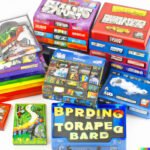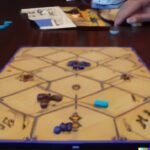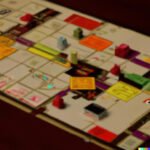Are you a fan of classic dungeon board games? Whether you’re a seasoned player or new to the genre, understanding the rules of these beloved games is essential for a successful and enjoyable gaming experience. Classic dungeon board game rules are designed to create an immersive and challenging gameplay environment that keeps players coming back for more. From strategic decision-making to thrilling adventures, these rules set the stage for hours of entertainment.
In this article, we will delve into the world of classic dungeon board games, exploring their history, rules, components, and strategies. Whether you’re looking to brush up on your knowledge or are a newcomer eager to learn more, this comprehensive guide will provide valuable insights into the exciting realm of classic dungeon board games. Get ready to embark on an epic journey through dungeons, battles, and treasure hunts as we uncover the intricacies of these timeless tabletop adventures.
From their humble beginnings to their modern-day popularity, classic dungeon board games have captured the hearts and minds of players around the world. As we trace the evolution of these beloved games, we’ll gain a deeper appreciation for their enduring appeal and innovative gameplay mechanics.
Plus, we’ll explore tips for beginners and advanced players alike, equipping you with the knowledge and strategies needed to conquer any dungeon that comes your way. So grab your gear, gather your party, and get ready to dive into the captivating world of classic dungeon board games.
History of Classic Dungeon Board Games
The history of classic dungeon board games is a rich and storied one, with roots that can be traced back to the early 1970s. The first game to truly establish the genre was Dungeons & Dragons, created by Gary Gygax and Dave Arneson in 1974.
This groundbreaking game set the standard for the fantasy role-playing experience, featuring an immersive world of monsters, treasures, and perilous adventures. It quickly became a cultural phenomenon and laid the foundation for the classic dungeon board games that followed.
As the popularity of Dungeons & Dragons grew, so too did the demand for more accessible and streamlined dungeon-crawling experiences. In response, a slew of classic dungeon board games were released throughout the 1980s and beyond, offering players a chance to partake in thrilling adventures without the need for extensive rulebooks or character sheets.
Games like HeroQuest, Warhammer Quest, and Descent: Journeys in the Dark expanded upon the formula introduced by Dungeons & Dragons, introducing new mechanics and approaches to gameplay while remaining true to their lineage.
With each passing year, classic dungeon board games continued to evolve and innovate. New titles emerged that catered to a wide range of preferences, from cooperative experiences where players worked together against devious game-controlled foes to competitive affairs where heroes vied for glory against each other as well as against malevolent monsters lurking within dark dungeons. Today, classic dungeon board games remain as popular as ever – championing nostalgia for veterans while enticing newcomers with exciting gameplay opportunities.
| Classic Dungeon Board Game | Release Year |
|---|---|
| Dungeons & Dragons | 1974 |
| HeroQuest | 1989 |
| Warhammer Quest | 1995 |
Overview of Classic Dungeon Board Game Rules
Classic dungeon board games have been a popular form of entertainment for decades. These games, often set in a fantasy world, involve players navigating through a maze-like dungeon, encountering monsters, collecting treasure, and ultimately achieving a specific goal. The rules of these classic dungeon board games are essential to understanding how to play and enjoy the game to its fullest potential.
History of Classic Dungeon Board Games
The history of classic dungeon board games dates back to the 1970s with the introduction of “Dungeon.” by TSR, Inc. Since then, various iterations and spin-offs have been created, each offering unique gameplay experiences while still adhering to the core principles of classic dungeon board game rules. Over the years, these games have continued to captivate players with their immersive themes and strategic gameplay.
The basic rules of classic dungeon board games typically involve players taking turns moving their characters through the dungeon, drawing encounter cards to determine what they face in each room, rolling dice for combat or skill checks, and making decisions that can affect their progress. These games also incorporate elements such as character abilities, equipment management, and resource allocation. Understanding and mastering these rules is crucial for success in classic dungeon board games.
| Key Concepts | Description |
|---|---|
| Turn-based Gameplay | Players take turns moving through the dungeon and engaging in encounters. |
| Dice Rolling | Dice are used for combat, skill checks, and determining outcomes of certain actions. |
| Exploration and Decision Making | Players must explore rooms, make strategic decisions, and manage resources effectively. |
Components and Set-Up for Classic Dungeon Board Games
When it comes to classic dungeon board games, the components and set-up are essential for creating an immersive and enjoyable gaming experience. These games typically come with a variety of components that contribute to building the game world and setting the stage for adventure. Understanding the components and how to set up the game properly is crucial for players to fully engage with the gameplay.
Components
Classic dungeon board games often come with a range of components, including a game board, character minis, dice, cards, tokens, and other pieces that represent various elements of the game world. The game board typically showcases different rooms, corridors, and obstacles that players will navigate as they progress through the dungeon.
Character minis represent each player’s avatar within the game, while dice are used for resolving combat, skill checks, and other actions. Cards and tokens often provide additional information or resources that players can use during their quest.
Set-Up
The set-up for classic dungeon board games usually involves arranging the game board according to specific instructions provided in the rulebook. Players will then place their character minis at a designated starting point on the board. Other components such as cards and tokens may need to be sorted and placed within easy reach of all players. Additionally, any enemy minis or obstacles might need to be strategically placed on the board to create an initial challenge for players.
Preparation
Before diving into gameplay, it’s important for players to familiarize themselves with all the components and understand their functions within the game. This includes reviewing any specific rules or special abilities associated with certain cards or tokens. Players should also take this time to establish a clear understanding of their objectives and goals within the game so that they can strategize effectively from the start.
Overall, taking time with setting up classic dungeon board games not only enhances gameplay but also helps build anticipation for what is bound to be an exciting adventure throughout each unique dungeon.
Gameplay Mechanics and Strategies for Classic Dungeon Board Games
In classic dungeon board games, the gameplay mechanics and strategies are essential to master in order to emerge victorious. These games often involve navigating through a labyrinthine dungeon, battling monsters, collecting treasure, and completing quests. Understanding the rules and developing effective strategies is crucial for success in these immersive games.
Here are some key gameplay mechanics and strategies for classic dungeon board games:
1. Movement: Players must navigate their characters through the dungeon, making strategic decisions about which paths to take and which areas to explore. Movement can be affected by obstacles such as traps, locked doors, or secret passages.
2. Combat: Engaging in combat is a central element of classic dungeon board games. Players must use their characters’ abilities and equipment to defeat monsters and other adversaries. Understanding the combat rules, including attack rolls, defense rolls, and damage calculation, is essential for success in battles.
3. Resource Management: Managing resources such as health points, potions, spells, and equipment is crucial for survival in the dungeon. Players must make strategic decisions about when to use their resources and when to conserve them for future challenges.
Developing effective strategies for classic dungeon board games involves understanding the game’s mechanics, exploring different play styles, and adapting to unpredictable outcomes during gameplay. By mastering these gameplay mechanics and implementing strategic decision-making, players can enhance their chances of achieving victory in classic dungeon board games.
Variations and Expansions of Classic Dungeon Board Games
Classic dungeon board games have been around for decades and have seen numerous variations and expansions over the years. These variations and expansions add new elements, characters, quests, and challenges to the base game, keeping it fresh and exciting for players. Some of the most popular classic dungeon board game variations and expansions include:
- Different Game Settings: Some variations of classic dungeon board games take place in different settings such as futuristic outer space, medieval times, or post-apocalyptic worlds. These settings not only change the theme of the game but also introduce new enemies and allies for players to encounter.
- Expansion Packs: Many classic dungeon board games offer expansion packs that add new characters, missions, items, and rules to the base game. These expansions often deepen the gameplay experience by introducing new mechanics or increasing the overall challenge for players.
- Customizable Content: Some variations of classic dungeon board games allow players to create their own content, including custom dungeons, characters, monsters, and more. This level of customization provides endless possibilities for players to explore and enjoy.
With these various options available, players can tailor their classic dungeon board gaming experience to their preferences and playstyle. Whether they prefer a more challenging game with expansion packs or a customizable experience with user-generated content, there is something for every type of player.
It’s worth noting that while these variations and expansions enhance the original classic dungeon board game rules, they also require careful consideration when integrating them into gameplay. Players should familiarize themselves with any new components or rules before diving into these expanded versions to ensure a smooth gaming experience without confusion or frustration. Ultimately, these additions bring even more depth and excitement to an already beloved genre of tabletop gaming.
Tips for Beginners and Advanced Players
Know the Rules
Before you start playing a classic dungeon board game, it is essential to thoroughly understand the rules. Familiarize yourself with the components, set-up, gameplay mechanics, and strategies. This will help you make informed decisions during the game and avoid any confusion or misunderstandings with other players.
Develop Your Strategy
For beginners, it’s important to start with a simple strategy and gradually build upon it as you gain more experience. Consider your character’s strengths and weaknesses, as well as the various ways to achieve victory in the game. Advanced players should continuously refine their strategies and adapt them based on their opponents’ moves.
Embrace Variations and Expansions
To add more excitement to your classic dungeon board game experience, consider exploring variations and expansions of the game. This can introduce new challenges, mechanics, and elements that keep the game fresh and engaging for both beginners and advanced players. Experimenting with different variations can also help improve your overall understanding of the game.
By following these tips for beginners and advanced players, you can enhance your skills in classic dungeon board games and make each gaming session more enjoyable and rewarding. Whether you are just starting or looking to take your gameplay to the next level, these strategies will help you become a more proficient player in this beloved genre of board games.
Conclusion and Recommended Classic Dungeon Board Games for New Players
In conclusion, classic dungeon board games have a rich history and continue to be a beloved pastime for many players. The rules of these games have evolved over time, but the core mechanics remain true to their origins. Whether you’re a beginner or an advanced player, there are countless ways to enjoy these timeless games.
For new players looking to delve into the world of classic dungeon board games, it’s essential to start with the foundational rules that have stood the test of time. Understanding the components and set-up is crucial for a successful gaming experience, and learning about gameplay mechanics and strategies will help players navigate the dungeons with confidence.
As for recommended classic dungeon board games for new players, there are several standout options that offer engaging gameplay and immersive experiences. Games like Dungeons & Dragons, HeroQuest, and Warhammer Quest are excellent choices for those looking to embark on their first dungeon-crawling adventure.
These games not only showcase the classic dungeon board game rules but also provide an opportunity for players to explore rich storytelling and collaborative gameplay. With so many variations and expansions available, there’s always something new to discover in the world of classic dungeon board games.
Frequently Asked Questions
How to Do Classic WoW Dungeons?
Classic WoW dungeons are a key part of the game’s content. To do them, players must form a group with specific roles (tank, healer, damage dealer) and travel to the dungeon entrance. Once inside, they work together to defeat bosses and enemies, complete quests, and obtain valuable loot.
How Many People Can Play Dungeon Board Game?
The number of people who can play a dungeon board game can vary depending on the specific game. Some dungeon board games are designed for 2-4 players, while others can accommodate larger groups of 5-6 or even more. The player count is usually specified on the game box or in the instructions.
What Is the History of Dungeon Board Game?
The history of dungeon board games dates back to the early days of tabletop gaming. One of the most influential early dungeon crawl games was “Dungeons & Dragons,” which was first published in 1974. This seminal role-playing game set the stage for many future dungeon board games by popularizing fantasy storytelling and adventure themes within a structured game format.

I love playing all kinds of games – from classics like Monopoly to modern favourites like Ticket to Ride.
I created this blog as a way to share my love of board games with others, and provide information on the latest releases and news in the industry.





